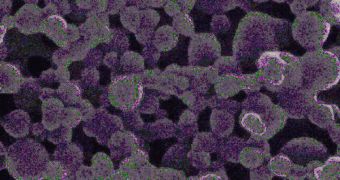A new find is about to change the way medicine has been practiced over the past few centuries, experts from the Queen Mary, University of London have announced. The researchers have just finished developing their micro-shuttles, micro-particles that will be used to gradually deliver drugs to an affected area. This will eliminate the need for traditional dosing, which has been in use since the first drugs were created.
Each of the new capsules has a diameter of only two micrometers, or roughly the size of a bacteria. They are obtained by wrapping strand after strand of metabolism-resistant material over a spherical particle, which is then dissolved using acid. The end-result is a sphere made of the material, but with an empty core, in which other substances, such as vaccines, genes, and others, can be placed. Filling the particles is done in a simple manner, by heating the empty containers in a solution that contains the required drug. As a result, the capsules shrink and trap some of the drug molecules inside.
“The main advantage of using such microcapsules is that they can be designed to be very stable inside the body, protecting their contents. This is particularly important for the many medications that are rapidly degraded or altered by the body. These capsules can be used to 'store' drugs in the body for later use,” Queen Mary School of Engineering and Materials Science PhD student Matthieu Bedard explains. He worked closely with Professor Gleb Sukhorukov on devising the new micro-shuttles. Dr. Sebastian Springer, from the Jacobs University, in Bremen, Germany, and colleagues from the Max Plank Institute of Colloids also played an important role in designing the microcapsules.
“This new technique could have many biological applications, including delivering DNA into cells for gene therapy. The capsules could also be filled in with magnetic particles that collect and extract minuscule samples from inside cells. Other applications could see patients needing internal medication after surgery being administered drugs without the need for further invasive procedures or hospital visits. However, there are still questions about how to direct the capsules to the right cells as well as finding a way to make capsules that are safe for human use. It is possible that we will see useful applications for this technology being tested in the next five years,” Sukhorukov adds.
In experiments, the capsules were delivered to cells via a method known as electroporation. A tiny, electric shock was applied to a tissue, and the membrane of cells inside became permeable to micrometer-sized particles. An infrared laser beam was then shone on the microcapsules. The laser was not strong enough to affect the living tissue, but it influenced the activity of gold nanoparticles in the capsules' walls, and allowed for the gradual release of the drug, the team reports, quoted by e! Science News.

 14 DAY TRIAL //
14 DAY TRIAL //